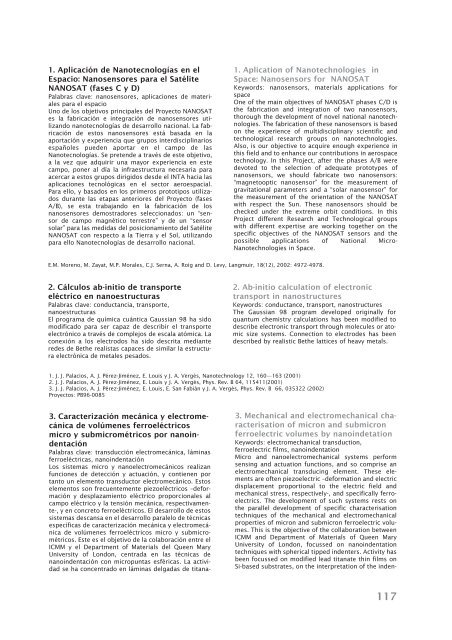Instituto de Ciencia de Materiales de Madrid - Materials Science ...
Instituto de Ciencia de Materiales de Madrid - Materials Science ...
Instituto de Ciencia de Materiales de Madrid - Materials Science ...
You also want an ePaper? Increase the reach of your titles
YUMPU automatically turns print PDFs into web optimized ePapers that Google loves.
1. Aplicación <strong>de</strong> Nanotecnologías en el<br />
Espacio: Nanosensores para el Satélite<br />
NANOSAT (fases C y D)<br />
Palabras clave: nanosensores, aplicaciones <strong>de</strong> materiales<br />
para el espacio<br />
Uno <strong>de</strong> los objetivos principales <strong>de</strong>l Proyecto NANOSAT<br />
es la fabricación e integración <strong>de</strong> nanosensores utilizando<br />
nanotecnologías <strong>de</strong> <strong>de</strong>sarrollo nacional. La fabricación<br />
<strong>de</strong> estos nanosensores está basada en la<br />
aportación y experiencia que grupos interdisciplinarios<br />
españoles pue<strong>de</strong>n aportar en el campo <strong>de</strong> las<br />
Nanotecnologías. Se preten<strong>de</strong> a través <strong>de</strong> este objetivo,<br />
a la vez que adquirir una mayor experiencia en este<br />
campo, poner al día la infraestructura necesaria para<br />
acercar a estos grupos dirigidos <strong>de</strong>s<strong>de</strong> el INTA hacia las<br />
aplicaciones tecnológicas en el sector aeroespacial.<br />
Para ello, y basados en los primeros prototipos utilizados<br />
durante las etapas anteriores <strong>de</strong>l Proyecto (fases<br />
A/B), se esta trabajando en la fabricación <strong>de</strong> los<br />
nanosensores <strong>de</strong>mostradores seleccionados: un “sensor<br />
<strong>de</strong> campo magnético terrestre” y <strong>de</strong> un “sensor<br />
solar” para las medidas <strong>de</strong>l posicionamiento <strong>de</strong>l Satélite<br />
NANOSAT con respecto a la Tierra y el Sol, utilizando<br />
para ello Nanotecnologías <strong>de</strong> <strong>de</strong>sarrollo nacional.<br />
1. Aplication of Nanotechnologies in<br />
Space: Nanosensors for NANOSAT<br />
Keywords: nanosensors, materials applications for<br />
space<br />
One of the main objectives of NANOSAT phases C/D is<br />
the fabrication and integration of two nanosensors,<br />
thorough the <strong>de</strong>velopment of novel national nanotechnologies.<br />
The fabrication of these nanosensors is based<br />
on the experience of multidisciplinary scientific and<br />
technological research groups on nanotechnologies.<br />
Also, is our objective to acquire enough experience in<br />
this field and to enhance our contributions in aerospace<br />
technology. In this Project, after the phases A/B were<br />
<strong>de</strong>voted to the selection of a<strong>de</strong>quate prototypes of<br />
nanosensors, we should fabricate two nanosensors:<br />
“magnetooptic nanosensor” for the measurement of<br />
gravitational parameters and a “solar nanosensor” for<br />
the measurement of the orientation of the NANOSAT<br />
with respect the Sun. These nanosensors should be<br />
checked un<strong>de</strong>r the extreme orbit conditions. In this<br />
Project different Research and Technological groups<br />
with different expertise are working together on the<br />
specific objectives of the NANOSAT sensors and the<br />
possible applications of National Micro-<br />
Nanotechnologies in Space.<br />
E.M. Moreno, M. Zayat, M.P. Morales, C.J. Serna, A. Roig and D. Levy, Langmuir, 18(12), 2002: 4972-4978.<br />
2. Cálculos ab-initio <strong>de</strong> transporte<br />
eléctrico en nanoestructuras<br />
Palabras clave: conductancia, transporte,<br />
nanoestructuras<br />
El programa <strong>de</strong> química cuántica Gaussian 98 ha sido<br />
modificado para ser capaz <strong>de</strong> <strong>de</strong>scribir el transporte<br />
electrónico a través <strong>de</strong> complejos <strong>de</strong> escala atómica. La<br />
conexión a los electrodos ha sido <strong>de</strong>scrita mediante<br />
re<strong>de</strong>s <strong>de</strong> Bethe realistas capaces <strong>de</strong> similar la estructura<br />
electrónica <strong>de</strong> metales pesados.<br />
2. Ab-initio calculation of electronic<br />
transport in nanostructures<br />
Keywords: conductance, transport, nanostructures<br />
The Gaussian 98 program <strong>de</strong>veloped originally for<br />
quantum chemistry calculations has been modified to<br />
<strong>de</strong>scribe electronic transport through molecules or atomic<br />
size systems. Connection to electro<strong>de</strong>s has been<br />
<strong>de</strong>scribed by realistic Bethe lattices of heavy metals.<br />
1. J. J. Palacios, A. J. Pérez-Jiménez, E. Louis y J. A. Vergés, Nanotechnology 12, 160—163 (2001)<br />
2. J. J. Palacios, A. J. Pérez-Jiménez, E. Louis y J. A. Vergés, Phys. Rev. B 64, 115411(2001)<br />
3. J. J. Palacios, A. J. Pérez-Jiménez, E. Louis, E. San Fabián y J. A. Vergés, Phys. Rev. B 66, 035322 (2002)<br />
Proyectos: PB96-0085<br />
3. Caracterización mecánica y electromecánica<br />
<strong>de</strong> volúmenes ferroeléctricos<br />
micro y submicrométricos por nanoin<strong>de</strong>ntación<br />
Palabras clave: transducción electromecánica, láminas<br />
ferroeléctricas, nanoin<strong>de</strong>ntación<br />
Los sistemas micro y nanoelectromecánicos realizan<br />
funciones <strong>de</strong> <strong>de</strong>tección y actuación, y contienen por<br />
tanto un elemento transductor electromecánico. Estos<br />
elementos son frecuentemente piezoeléctricos –<strong>de</strong>formación<br />
y <strong>de</strong>splazamiento eléctrico proporcionales al<br />
campo eléctrico y la tensión mecánica, respectivamente-,<br />
y en concreto ferroeléctricos. El <strong>de</strong>sarrollo <strong>de</strong> estos<br />
sistemas <strong>de</strong>scansa en el <strong>de</strong>sarrollo paralelo <strong>de</strong> técnicas<br />
específicas <strong>de</strong> caracterización mecánica y electromecánica<br />
<strong>de</strong> volúmenes ferroeléctricos micro y submicrométricos.<br />
Este es el objetivo <strong>de</strong> la colaboración entre el<br />
ICMM y el Department of <strong>Materials</strong> <strong>de</strong>l Queen Mary<br />
University of London, centrada en las técnicas <strong>de</strong><br />
nanoin<strong>de</strong>ntación con micropuntas esféricas. La actividad<br />
se ha concentrado en láminas <strong>de</strong>lgadas <strong>de</strong> titana-<br />
3. Mechanical and electromechanical characterisation<br />
of micron and submicron<br />
ferroelectric volumes by nanoin<strong>de</strong>tation<br />
Keywords: electromechanical transduction,<br />
ferroelectric films, nanoin<strong>de</strong>ntation<br />
Micro and nanoelectromechanical systems perform<br />
sensing and actuation functions, and so comprise an<br />
electromechanical transducing element. These elements<br />
are often piezoelectric –<strong>de</strong>formation and electric<br />
displacement proportional to the electric field and<br />
mechanical stress, respectively-, and specifically ferroelectrics.<br />
The <strong>de</strong>velopment of such systems rests on<br />
the parallel <strong>de</strong>velopment of specific characterisation<br />
techniques of the mechanical and electromechanical<br />
properties of micron and submicron ferroelectric volumes.<br />
This is the objective of the collaboration between<br />
ICMM and Department of <strong>Materials</strong> of Queen Mary<br />
University of London, focussed on nanoin<strong>de</strong>ntation<br />
techniques with spherical tipped in<strong>de</strong>nters. Activity has<br />
been focussed on modified lead titanate thin films on<br />
Si-based substrates, on the interpretation of the in<strong>de</strong>n-<br />
117

















